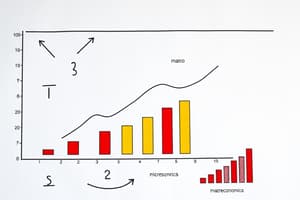Podcast
Questions and Answers
What does microeconomics primarily analyze?
What does microeconomics primarily analyze?
- The overall economy and gross domestic product
- Government spending and taxation policies
- Individual consumers and businesses (correct)
- International trade and exchange rates
Which market structure is characterized by many buyers and sellers with no control over prices?
Which market structure is characterized by many buyers and sellers with no control over prices?
- Monopolistic Competition
- Monopoly
- Perfect Competition (correct)
- Oligopoly
What is the opportunity cost in economic terms?
What is the opportunity cost in economic terms?
- The cost of the least favored alternative forgone (correct)
- The total cost of production in a given market
- Any costs that cannot be recovered
- The benefits gained from the best alternative chosen
What does the unemployment rate measure?
What does the unemployment rate measure?
Which economic system is defined by private ownership and free markets?
Which economic system is defined by private ownership and free markets?
Fiscal policy includes which of the following components?
Fiscal policy includes which of the following components?
How does globalization influence economies?
How does globalization influence economies?
What primarily drives the law of demand?
What primarily drives the law of demand?
Flashcards are hidden until you start studying
Study Notes
Economic Concepts
- Definition: Economics is the study of how individuals and societies use limited resources to satisfy unlimited wants.
Major Branches of Economics
-
Microeconomics:
- Focuses on individual consumers and businesses.
- Analyzes supply and demand, pricing, and competition.
-
Macroeconomics:
- Examines the economy as a whole.
- Studies aggregate indicators like GDP, unemployment, inflation, and economic growth.
Key Economic Principles
- Scarcity: Limited resources vs. unlimited wants leads to trade-offs.
- Opportunity Cost: The cost of forgoing the next best alternative when making a choice.
- Supply and Demand:
- Law of Demand: As prices decrease, demand increases, and vice versa.
- Law of Supply: As prices increase, supply typically increases, and vice versa.
Market Structures
- Perfect Competition: Many buyers and sellers, no single entity can control prices.
- Monopoly: A single seller dominates the market, controls prices.
- Oligopoly: A few sellers dominate the market; interdependence affects pricing and output.
- Monopolistic Competition: Many competitors sell products that are differentiated from one another.
Economic Indicators
- Gross Domestic Product (GDP): Measurement of all goods and services produced over a specific time period.
- Unemployment Rate: Percentage of the labor force that is jobless and seeking employment.
- Inflation Rate: Increase in the price level of goods and services over time.
Economic Systems
- Capitalism: Characterized by private ownership and free markets.
- Socialism: Major industries are owned or regulated by the state.
- Mixed Economy: Combination of capitalist and socialist elements.
Fiscal and Monetary Policy
- Fiscal Policy: Government spending and taxation policies to influence the economy.
- Monetary Policy: Central bank actions (like interest rates and money supply) aimed at controlling inflation and stabilizing currency.
International Economics
- Trade: Exchange of goods and services between countries; can be influenced by tariffs and quotas.
- Exchange Rates: Value of one currency for the purpose of conversion to another; affects international trade competitiveness.
Recent Trends in Economics
- Globalization: The increasing interdependence of economies worldwide.
- Sustainability: Growing focus on environmental factors and sustainable practices in economic planning.
- Digital Economy: Growth in the use of digital technologies transforms business models and economic activities.
Economics Definition
- Economics examines how societies and individuals utilize limited resources to meet unlimited wants and desires.
Important Branches of Economics
- Microeconomics analyzes individual consumers and businesses.
- Key focuses include pricing, competition, supply and demand
- Macroeconomics focuses on the economy as a whole
- Key focuses include aggregate indicators like GDP, inflation, and unemployment
Essential Economic Principles
- Scarcity is the core concept in economics, limited resources and unlimited desires require decision-making and trade-offs when allocating resources
- Opportunity Cost is the value of the next best alternative forgone when making a choice.
- Supply and Demand are fundamental economic principles.
- Law of Demand: Inverse relationship between price and demand.
- Law of Supply: Direct relationship between price and supply.
Market Structures
- Perfect Competition features many buyers and sellers, no single entity controls prices.
- Monopoly is characterized by a single seller dominating the market and dictating prices.
- Oligopoly features a few dominant sellers, interdependence influences output and pricing.
- Monopolistic Competition is comprised of many competitors selling differentiated products.
Key Economic Indicators
- Gross Domestic Product (GDP) measures the value of all goods and services produced in a nation over a specific period.
- Unemployment Rate reflects the percentage of the labor force actively seeking employment but without jobs.
- Inflation Rate measures the rate of price increases for goods and services over time.
Economic Systems
- Capitalism promotes private ownership and free markets.
- Socialism emphasizes state ownership or regulation of major industries.
- Mixed Economy combines elements of both capitalism and socialism.
Fiscal and Monetary Policy
- Fiscal Policy involves government actions like spending and taxation to influence the economy.
- Monetary Policy involves central bank actions like managing interest rates and the money supply to stabilize the currency and control inflation.
International Economics
- Trade is the exchange of goods and services between countries, affected by factors like tariffs and quotas.
- Exchange Rates determine the value of one currency relative to another, impacting competitiveness in international trade.
Recent Trends in Economics
- Globalization refers to the increasing interconnectedness of economies worldwide.
- Sustainability emphasizes incorporating environmental considerations and sustainable practices into economic planning.
- Digital Economy refers to the growth of digital technologies and their impact on business models and economic activities.
Studying That Suits You
Use AI to generate personalized quizzes and flashcards to suit your learning preferences.




